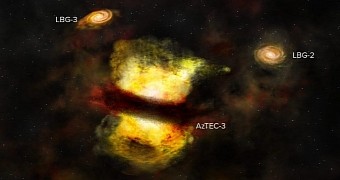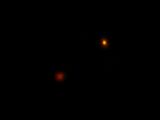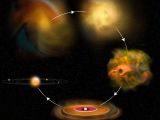In a paper published in yesterday's issue of the Astrophysical Journal, astronomers tell the tale of a distant galaxy that is now busy forming stars at an oddly rapid pace.
Thus, this galaxy is birthing stars thousands of times faster than our Milky Way. In fact, it is said to form more stars in one day than the Milky Way does throughout the course of an entire year.
Because of how prolific the galaxy is in this day and age, scientists with the National Radio Astronomy Observatory refer to it as a cosmic powerhouse. They go on to argue that its star-forming abilities are nothing short of impressive.
Introducing the freakishly hyperactive galaxy
Writing in the Astrophysical Journal, astronomers detail that this galaxy goes by the name of AzTEC-3. It is located at a distance of about 12.5 billion light-years from our planet in the constellation Sextans, and is kept company by three other smaller and much calmer galaxies.
As shown in the image accompanying this article, AzTEC-3 is nestled between these three smaller galaxies, identified as LBG-1, LBG-2 and LBG-3. When compared to its neighbors, AzTEC-3 is way bigger and way more active.
It is estimated that, at least in this stage of its evolution, the galaxy is producing stars at a rate some 1,000 times faster than the one documented in the case of the Milky Way. LBG-1, LBG-2 and LBG-3 are also producing stars, but at a normal pace.
“The ALMA data reveal that AzTEC-3 is a very compact, highly disturbed galaxy that is bursting with new stars at close to its theoretically predicted maximum limit and is surrounded by a population of more normal, but also actively star-forming galaxies,” explains astronomer Dominik Riechers.
Having taken the time to study its anatomy and behavior, scientists found that, unlike other galaxies, AzTEC-3 displays very little dust and gas rotation, indicating that, at some point in its history, its motion was disrupted.
It is believed that both the rapid pace at which the galaxy is now forming stars and this disrupted motion are the result of a merger with another galaxy. Besides, it is argued that this merger probably did not take place very long ago.
“AzTEC-3 is currently undergoing an extreme, but short-lived event. This is perhaps the most violent phase in its evolution, leading to a star formation activity level that is very rare at its cosmic epoch,” says researcher Dominik Riechers.
Identifying a distant protocluster
Scientists with the National Radio Astronomy Observatory claim that AzTEC-3, together with LBG-1, LBG-2 and LBG-3, forms an emerging protocluster. As detailed in the Astrophysical Journal, protoclusters are systems comprising galaxies that, although not gravitationally bound to one another, like to hang together.
The astronomers hope that, by studying AzTEC-2 and its companions in further detail, they will manage to get a better understanding of how massive galaxies are born through the merger of smaller ones, and of how galaxies come together to form clusters.

 14 DAY TRIAL //
14 DAY TRIAL // 



